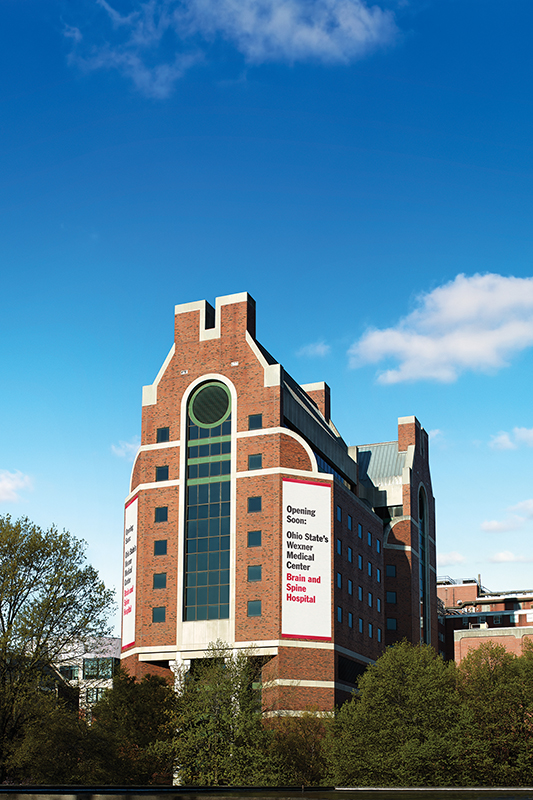
The Brain and Spine Hospital, 300 W. 10th Ave., will be located on South Campus. Credit: Courtesy of The Ohio State University Wexner Medical Center
Construction on three floors of a new Brain and Spine Hospital will expand the Ohio State University Wexner Medical Center’s Neurological Institute by renovating 59,000 square feet at 300 W. 10th Ave.
Approved by Ohio State’s Board of Trustees, the project will create room for 87 private beds spread throughout the eighth, ninth and tenth floors of the old James Cancer Hospital that will have the latest technology and qualified experts to provide care for any patients with brain and spine conditions such as Parkinson’s, Alzheimer’s and amyotrophic lateral sclerosis, also known as Lou Gehrig’s disease.
“Our facility will be unique in providing the latest technology for the diagnosis and care of patients and leveraging the tremendous expertise of our world-class faculty of clinicians and researchers,” said Dr. Ali Rezai, the director and CEO of the OSU Wexner Medical Center’s Neurological Institute. “The advances and discoveries resulting from our efforts at the new Brain and Spine Hospital provide the future standards of care for other facilities across the nation.”
The construction and renovations are set to be completed in Autumn 2016, Lucas said.
The initial budget was $14.3 million, but a $3.3 million increase was recently approved by the Board of Trustees giving the project a total budget of $17.6 million, which will be paid with university and auxiliary funds, said Amanda Lucas, the executive director of clinical operations for the OSU Wexner Medical Center’s Neurological Institute. The construction will begin in January.
With neurological disorders affecting around 50 million people in America, and nearly 1 billion people across the world, there is a strong need for this hospital at OSU, Rezai said.
“As a growing number of patients in the U.S. are affected by disorders of the brain and the spine, we need to have a new dedicated facility to best take care of these patients,” he said.
In addition, Rezai said that neuroscience and neurological care hospitals are major growth areas for the future of medicine, as more people will suffer from brain and spine conditions as the population gets older.
“Every 40 seconds, someone suffers a stroke, and every four minutes, someone dies from a stroke. Every 15 seconds, someone suffers a traumatic brain injury,” he said. “The number of patients with Alzheimer’s is growing rapidly. One in three seniors will die with dementia.”
Once the renovations are complete, the three floors will be structured by different neurological disorders and conditions in order to give patients the best possible care from a combination of staff, equipment and technology, Rezai said.
“The hospital is organized into specialty care units focusing on brain injury, spinal cord injury, stroke, epilepsy and other conditions,” he said. “The units will be managed by specialized care teams of physicians, nurses and many other health care specialists.”
Rezai said that the new hospital will also look to improve the treatment and diagnosis of patients, as it will have facilities to conduct research and clinical trials, and it will serve as a favorable healing environment for them.
“During the process of planning for the hospital, we are being cost efficient and, at the same time, focusing on providing the most coordinated advanced technology and healing environment for future care of our patients with brain and spine conditions,” he said.
While these renovations will be taking place at the start of the new year, other internal renovations to the building will be made in the main lobby. The outside of the building will undergo some changes as well, as a patio structure along the east side of the building and a cover over the main entrance will be added, Lucas said.
Jessica Frost, a second-year in nursing, said she feels that the hospital is a good development for OSU because she thinks that it is something that will benefit patients.
“I think the new hospital will be a good advancement because anything that can improve patient care is great,” she said. “Even though it is a lot of money, it’ll be a great improvement.”
The new Brain and Spine Hospital will be a part of the Neurological Institute of the OSU Wexner Medical Center, which is a university-wide initiative that involves the Nationwide Children’s Hospital and 14 of OSU’s colleges, such as engineering, pharmacy and dentistry, according to a press release from the Wexner Medical Center.
“We now have over 175 full-time physicians and scientists. We have nearly 12,000 in-patient admissions, perform over 4,000 surgeries and have more than 220,000 outpatient visits annually,” Rezai said. “Our faculty are conducting nearly 300 clinical trials per year to improve the care of our patients. This hospital is where the future of medicine will take place for discoveries and innovations to help improve diagnosis, patient care and cures.”


